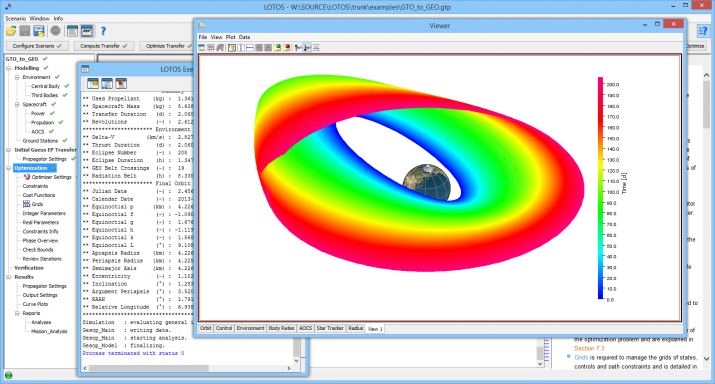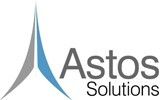-
StatusCompleted
-
Status date2015-06-11
The objective of the study was to develop a software tool for the analysis and optimization of high-fidelity transfer trajectories from launch orbit to GEO for spacecraft employing electric propulsion.
This activity takes a further step towards maturing such software for optimized electric propulsion manoeuvre planning and attitude guidance in order to prepare for support of actual spacecraft transfer planning.
Consequently, it has been a key objective of the activity to have proper validation of the optimization as well as the analysis features of the software and testing on commercially relevant telecom spacecraft scenarios.
SYSTEM ARCHITECTURE
As central hub of the LOTOS tool acts the GESOP (Graphical Environment for Simulation and OPtimization) core software which interfaces with the LOTOS model library and the optimizers to provide the required data flow. Some software main functionalities are handled by the GESOP core as well as many interactions to the user. Access to all software modes and functionalities is given via the graphical user interface and the command line interface.
The LOTOS model library computes the orbit transfers and all related data. It reads all scenario data defined by the user and stores it internally. With this data the orbit transfer trajectory dynamics can be computed as well as many additional outputs. Besides, the model library also computes and evaluates each user defined cost term (objective function) and constraint, which are both part of the optimal control problem. The model library of the LOTOS tool contains all relevant functions to provide mathematical computations, frame transformations, and all aerospace related features required for a very sophisticated evaluation and computation of electric orbit raisings and hybrid transfers under consideration of a comprehensive set of constraints.
One aim of the project was the support of hybrid orbit transfers, a chemical orbit-raising followed by an electric orbit-raising. It had to be implemented within the already existing architecture of the software, which up to then only supported low-thrust orbit transfers. Further, the computation of the electric orbit-raising had to be solved without involving a user controlled optimization process.
Another challenge was the implementation of a software feature to support ground operations and spacecraft autonomy by means of re-optimization of reference trajectories with updated initial state. For example, orbit determination is providing an updated spacecraft state which is then combined with the pre-computed reference trajectory and attitude profile.
For more precise refinements of eclipses and thrust/coast arcs, for example, the product has to support the exact evaluation of begin and end of an eclipse event. These conditions are met by additional constraints added to the optimal control problem.
The developed tool LOTOS (EORAO) is readily available for numerical optimization and analysis of most innovative electric orbit-raising scenarios as well as hybrid transfers. It features a dedicated verification process to assess the computed attitude control history with respect to accuracy and achievement of user defined transfer constraints. Its automatic computation of the initial guess, required for the optimization as initial solution, simplifies the whole process and usage. No further user interaction defining the attitude guiding laws is required.
LOTOS is perfectly suited for fast assessments of orbit transfers involving electric propulsion since it supports own analyses and automatic report functionalities. In general, multi-revolution orbit transfers lasting up to few years are supported. Initial and final orbit are user defined and provide the whole freedom required for all kind of missions.
A built-in batch processing tool further supports automatic computation of e.g. sensibility analyses. With lower need for user interaction it decreases the idle time of a system; large repeated jobs are done very fast and in sequence by the system. Particularly, the automated report generation is a key benefit. Besides, many small modifications can be combined into one large job which can be shared by multiple users.
The product LOTOS is an advanced tool for trajectory optimization and analysis of electric orbit-raising scenarios and hybrid transfers, where the chemical orbit-raising is followed by an electric orbit-raising. It allows simulation, optimization, verification and analysis of orbit transfer trajectories with electric (low-thrust) propulsion. For preparation and support of the spacecraft operations during the orbit transfer, LOTOS features the re-optimization of pre-computed attitude histories and optimal trajectories which has to be performed after an update of the spacecraft state by means of orbit determination. Since initial and final orbit are user defined, the tool is not just limited to typical GTO-GEO transfers of telecommunication satellites but offers a wide range of possible applications for low-thrust transfers such as constellation deployment and graveyarding.

Further, the product LOTOS features automatic computation of several analyses such as eclipses, GEO belt crossings, attitude constraint violations and ground station visibility. Additional analyses are related to special subsystem aspects of the spacecraft and comprise detailed information about slew rate violations, star tracker blindings, limitations of torque and wheel momentum as well as thruster firings.
With one click all user defined scenario data, all output and the results of the analyses can be used for automatic creation of mission analysis reports. Of course, each report is user customizable and several report templates are provided by the software to aid the mission analysis engineer.
Special feature of the product is the optimization capability. It does not only support time and fuel optimal transfer. Further, aspects like eclipse shutdown, bang-bang (on/off) thrust control, minimization of radiation, avoidance of the GEO ring crossings might be considered in the trajectory optimization. Since the software also supports full 6DoF attitude control, it is possible to constrain the slew rates of the spacecraft in the trajectory optimization process as well.
The project lasted 18 months with the following milestones:
Kick-off (KO): Project start
Software Requirements Review (SRR): All software requirements are consolidated.
Preliminary Design Review (PDR): A preliminary architectural design of the software is elaborated.
Critical Design Review (CDR): The design process is completed and the software tool is fully developed.
Acceptance Review (AR): All verification and validation tests have been successfully completed and the report finalized.
The project has been completed and the product is available as COTS software LOTOS (Low-thrust Orbit transfer Trajectory Optimization Software).



